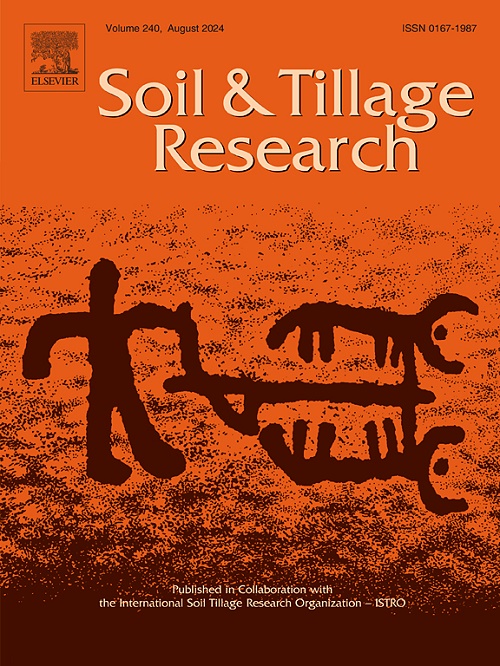Nitrogen-induced soil acidification mitigates the negative effects of nitrogen addition on SOC stability
IF 6.1
1区 农林科学
Q1 SOIL SCIENCE
引用次数: 0
Abstract
While nitrogen (N) deposition is a well-established driver of soil organic carbon (SOC) stability, quantitative syntheses assessing its global-scale impacts remain surprisingly limited. This study conducted a meta-analysis of 4418 observations from 131 independent studies to investigate how SOC, particulate organic carbon (POC), and mineral-associated organic carbon (MAOC) response to N addition. Our findings showed that N addition increased SOC (6.53 %), POC (12.59 %) and MAOC (3.45 %) pools. Nevertheless, the POC:SOC ratio increased by 5.46 %, whereas the MAOC:SOC ratio decreased by 2.2 %, indicating that N addition reduced SOC stability. Under N addition, soil acidification was categorized into three levels based on the magnitude of soil pH decline: non-acidified [≥ 0], mildly acidified [-0.5–0] and severely acidified [≤ -0.5]. Soil acidification inhibited the positive responses of SOC and POC to N addition. With increasing acidification, both SOC and POC declined progressively. In contrast, Soil acidification generally promoted the accumulation effect of N addition on MAOC, as the 4.21 % increase in MAOC under mild acidification exceeded the 0.25 % loss under severe acidification. Furthermore, the MAOC:SOC ratio steadily increased under N-addition treatments, indicating that N-induced soil acidification contributed to SOC stability. Overall, our study demonstrated that N-induced soil acidification mitigated the negative effects of N addition on SOC stability by regulating the POC and MAOC response to N addition. These findings underscore the crucial role of soil acidification in regulating SOC dynamics under N addition and offer new insights into the interactions between soil C and N.
氮诱导的土壤酸化减轻了氮素添加对有机碳稳定性的负面影响
虽然氮(N)沉积是土壤有机碳(SOC)稳定性的一个公认驱动因素,但评估其全球范围影响的定量综合仍然非常有限。本研究对来自131项独立研究的4418项观察结果进行了荟萃分析,以研究SOC、颗粒有机碳(POC)和矿物相关有机碳(MAOC)对N添加的响应。结果表明,氮的添加增加了有机碳(6.53 %)、POC(12.59 %)和MAOC(3.45 %)池。POC:SOC比增加了5.46 %,而MAOC:SOC比减少了2.2 %,表明施氮降低了SOC的稳定性。在N添加条件下,根据土壤pH值下降幅度将土壤酸化程度分为3个等级:非酸化[≥ 0]、轻度酸化[-0.5 -0]和严重酸化[≤ -0.5]。土壤酸化抑制了土壤有机碳和POC对N添加的正响应。随着酸化程度的增加,SOC和POC均呈递减趋势。土壤酸化总体上促进了N添加对MAOC的积累效应,轻度酸化下MAOC增加4.21 %,超过重度酸化下0.25 %的损失。此外,氮肥处理下土壤有机碳比稳步上升,表明土壤酸化有助于土壤有机碳的稳定。总体而言,我们的研究表明,N诱导的土壤酸化通过调节POC和MAOC对N添加的响应来减轻N添加对有机碳稳定性的负面影响。这些发现强调了土壤酸化在N添加下调节有机碳动态的关键作用,并为土壤C和N的相互作用提供了新的见解。
本文章由计算机程序翻译,如有差异,请以英文原文为准。
求助全文
约1分钟内获得全文
求助全文
来源期刊

Soil & Tillage Research
农林科学-土壤科学
CiteScore
13.00
自引率
6.20%
发文量
266
审稿时长
5 months
期刊介绍:
Soil & Tillage Research examines the physical, chemical and biological changes in the soil caused by tillage and field traffic. Manuscripts will be considered on aspects of soil science, physics, technology, mechanization and applied engineering for a sustainable balance among productivity, environmental quality and profitability. The following are examples of suitable topics within the scope of the journal of Soil and Tillage Research:
The agricultural and biosystems engineering associated with tillage (including no-tillage, reduced-tillage and direct drilling), irrigation and drainage, crops and crop rotations, fertilization, rehabilitation of mine spoils and processes used to modify soils. Soil change effects on establishment and yield of crops, growth of plants and roots, structure and erosion of soil, cycling of carbon and nutrients, greenhouse gas emissions, leaching, runoff and other processes that affect environmental quality. Characterization or modeling of tillage and field traffic responses, soil, climate, or topographic effects, soil deformation processes, tillage tools, traction devices, energy requirements, economics, surface and subsurface water quality effects, tillage effects on weed, pest and disease control, and their interactions.
 求助内容:
求助内容: 应助结果提醒方式:
应助结果提醒方式:


